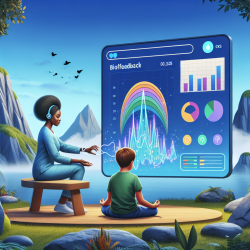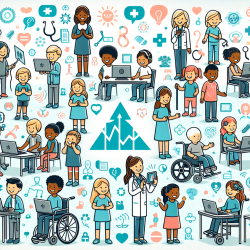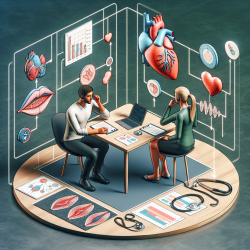Introduction
In the realm of therapeutic interventions, particularly for children, the integration of technology and evidence-based practices is crucial. The study "Using Biofeedback while Immersed in a Stressful Videogame Increases the Effectiveness of Stress Management Skills in Soldiers" offers valuable insights that can be adapted to improve outcomes in speech-language pathology. This blog explores how practitioners can leverage these findings to enhance their therapeutic approaches, particularly in stress management for children.
The Power of Biofeedback
Biofeedback is a technique that provides real-time data on physiological functions, enabling individuals to gain control over certain bodily processes. In the study, soldiers used biofeedback while immersed in a stressful videogame environment to practice stress management skills. The results were compelling: participants who engaged in biofeedback-assisted training showed significantly lower stress levels, as evidenced by reduced cortisol and heart rate levels, compared to those who did not receive such training.
Applying Research Insights to Child Therapy
While the study focused on military personnel, the principles can be translated into therapeutic settings for children. Here are some ways practitioners can implement these insights:
- Interactive Environments: Create engaging, child-friendly virtual environments where children can practice stress management techniques. This can be particularly beneficial for children with anxiety or sensory processing disorders.
- Real-Time Feedback: Use biofeedback devices to provide children with immediate information about their physiological responses. This can help them understand and manage their stress responses effectively.
- Incremental Challenges: Gradually increase the complexity of tasks in the virtual environment to build resilience and coping skills, similar to the progressive stress exposure used in the study.
Encouraging Further Research
The study underscores the importance of practice under realistic conditions. For practitioners, this highlights the need for further research into how biofeedback and virtual reality can be optimized for therapeutic use with children. Key areas for exploration include:
- Customization: How can virtual environments be tailored to meet the specific needs of individual children?
- Long-Term Effects: What are the long-term benefits of biofeedback training in stress management for children?
- Integration with Traditional Therapy: How can biofeedback be effectively integrated with existing therapeutic practices to enhance outcomes?
Conclusion
By embracing innovative approaches like biofeedback and immersive environments, practitioners can significantly enhance their therapeutic strategies. This not only aligns with data-driven decision-making but also holds the potential to improve outcomes for children, fostering resilience and better stress management skills.
To read the original research paper, please follow this link: Using Biofeedback while Immersed in a Stressful Videogame Increases the Effectiveness of Stress Management Skills in Soldiers.










